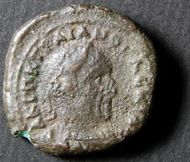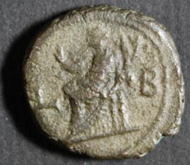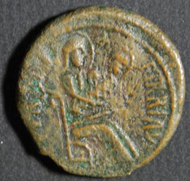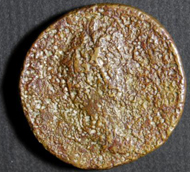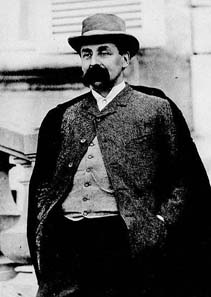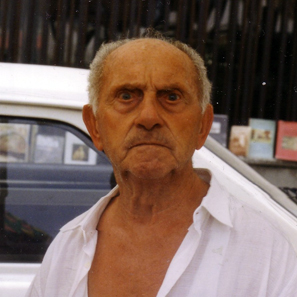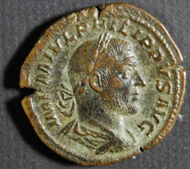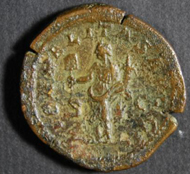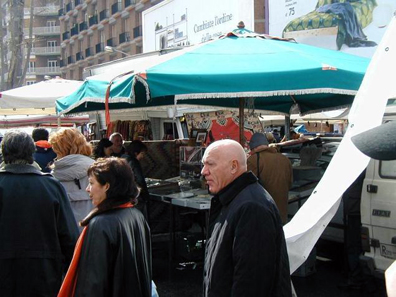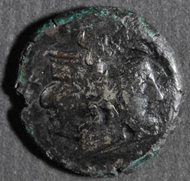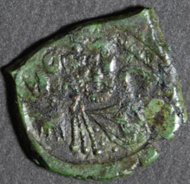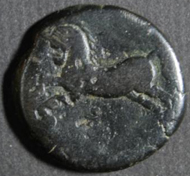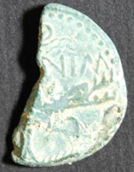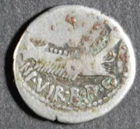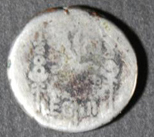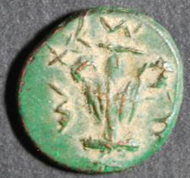December 20, 2012 – Like many of you, I began collecting coins as a youngster, looking through my parents’ pocket change, Red Book in hand, visiting the local coin store, and subscribing to those weird mail order outfits that send you coins on approval, as I recall mostly demonetized aluminum pieces from the far corners of the globe, mostly valueless but interesting and only pennies apiece.
Then in 1962 when I was 12, my family moved to Rome for 4 years, as my father, music critic for the Baltimore Sun, became Rome correspondent. Rome in 1962 was far more tranquil than today, but remained pretty impoverished, still showing the effects of WWII, in particular with many mutilati di guerra (war disabled), for whom designated seats were reserved on buses. In tobacconists, cigarettes could be bought by the one (also, people smoked tobacco taken from butts found on the street – I tried this, it was harsh), dads, moms, and infants scooted around together on Vespas (there were few cars), my YMCA summer camp – 6 weeks in Sardinia – cost all of $48, and bus tickets were 3 cents, although you could give the conductor a cigarette instead. Lots of smokers in those days! But things were changing fast in 1960s Italy. My family witnessed “il boom,” a steady progression toward prosperity.
My younger brother and I soon discovered Rome’s Flea Market, spread out through the streets south of Porta Portese, “the port gate”, along the Tiber in Trastevere. This sprawling market started after the War as a black and grey market, only on Sunday mornings, opening at first light in the old peasant way: out of bed in the dark so one could start working the fields as soon as it got light, after which a big late lunch, the meal of the day with wine, then siesta. Today some 4,000 sellers rent spots in these streets, selling everything from antique credenzas to used carburetors, stolen motorbikes, bootleg CDs, plastic birds that squawk “Ciao,” heaps of used clothes and cheap Chinese bags, old comic books, ancient Leicas and so forth, Russians selling icons and old military gear, Ethiopians exotic handwritten bibles, all in a carnival atmosphere of hollering and jostling, stall owners blaring badly dubbed dance music amid the smoke of corncobs roasting on the grill. In the ‘sixties some men used to play 3 card monte on little cardboard tables and I learned the hard way that painful rule, never play another man’s game. My father bought a fair amount of Greco-Roman art at the Flea Market, some of it pretty dubious, but always decorative.
As a young coin collector, what caught my eye were the buckets of ancient and medieval coins at a couple of Flea Market stands, and if you can forgive me the vulgar offense of mentioning price, the coins from these buckets were 50 lire – 8 cents – apiece, and my weekly allowance was 600 lire, a dollar, so I could afford them. Some of these coins got lost over the years, and I came to see that many of them were pretty shot, but I still have a few. The great contemporary collector of Greek coins Basil Demetriadis has said that every coin has something of interest. Maybe this is true of this sample from my early collecting days.
Trajan Decius, Egyptian tetradrachm, billon, year 2 = 251 AD
A K G M K TRAIANOS DEKIOS EV = Autokrator Caesar Gaius Messius Quintus… Pius; laureate draped and cuirassed bust. On the reverse, Homonoia seated l., right hand raised, holding a double cornucopia in l. L is probably a modification of the Egyptian hieroglyph for year; B is Greek for two. Trajan Decius, born in Serbia was a competent Senator and administrator but ruled only 2 years, persecuting Christians and dying in battle against the Goths. Note the tough guy portrait.
Next a bronze follaro of the Norman Ruggero I, Roger, “Grand Count of Calabria and Sicily,” from 1072 to 1101, struck at Mileto (his capital; he died here of old age). Struck between 1098 and 1101. Knight on horseback riding left, holding lance / The Virgin seated right on throne, holding Infant Christ, both wearing nimbus crown. MARIA This coin is actually a bit scarce.
Where were these bucket coins found? – an all-important question today, but not back in 1962. Especially with the advent of deep plowing after the war, peasants started finding a lot of old coins on their farms —their condition will tell whether in pot hoards or loose — and also in rivers, and so our third coin …
… this Antoninus Pius sestertius, another 8 cent coin, has what is called a “Tiber patina,” that is: no patina, and lots of corrosion, but you can see something. The attribution comes from the ruler’s profile. The reverse: Apollini Augusto SC, Apollo holding patera and lyre. Minted in 142 AD, early in Antoninus’ reign.
In ancient times, people dedicated coins to river gods, which sank into the mud at the bottom. Divers recovered 4,217 coins (but only 1 in 20 were sestertii) from the Liris River at Minturnae, south of Rome, where the Via Appia crossed it, plus anchors, amphoras, statuettes, lead seals, and military gear from WWII. Similarly, at Roman Piercebridge in the UK, divers found “hundreds of votive offerings including coins, brooches, rings, and figurines” of Cupid, a ram, and Hercules (Britannia 1999). These coin finds mostly represented the coins in circulation, and they were mostly Roman.
Gustave-Léon Schlumberger. Source: Wikipedia.
Where did the Flea Market non-Roman coins come from, like our Egyptian Trajan Decius tetradrachm? Did foreign coins circulate in imperial Italy? In his 1934 memoirs the famous French numismatist Gustave Schlumberger described his own coin-collecting youth in mid nineteenth-century Pau, in southwest France.
He wrote, “it is difficult to imagine the extraordinary macédoine of copper pieces of all sorts that could arrive by evening in the shops’ large drawers, after the crowd of neighboring countrymen had passed during the day, at the épicerie Malan or the haberdasher Cazalis. Beside brand new pennies of Napoleon III, pennies and farthings already worn pretty smooth of the two Republics and of Louis XVI …, one found there coppers of all the kings of Spain, of the popes, of the Kings of Portugal, of all the princes of Italy, Piedmont, Lombardy, Naples; plus numerous tokens both French and foreign; above all an immense quantity of bronzes of the Roman emperors, unearthed by the peasants’ ploughs, almost always very worn, and immediately returned to circulation. Everything was accepted. I saw, in these extraordinary drawers, even some ancient Greek coins and many Celtiberian pieces, struck by the peoples of Spain before and after the Roman occupation … Similarly, the silver coins that circulated belonged to all the nations of the earth. None was refused. I saw, in bags of 100 coins, up to twenty kinds of crowns of different origins, from the beautiful issues of King Murat to the scudi of Popes Pius VI or Pius VII.” (G. Schlumberger, Mes souvenirs, 1844-1928, vol. 1 (Paris 1934) 38-39.)
In ancient and medieval Italy a similar if perhaps not so extreme situation will have prevailed, especially in isolated areas that did not strike their own coins but had been monetized. How did that Trajan Decius get to Italy? Along with Egyptian wheat? In the purses of Roman soldiers? Or did perhaps a more recent tourist carry it to Italy as a souvenir?
Since the 1980s I’ve often traveled to Rome and always return to the Flea Market if I’m in town on a Sunday. Until quite recently, people still set up in the dark, and started selling as soon as it got light. Here are photos of the main two Flea Market coin dealers …
Bruno Nobili. By courtesy of his family and cittamese.it
… first Bruno Nobili, in the 80s he told me he’d been selling all kinds of coins and paper money in the Market every Sunday for 28 years. Short, solid, red faced, taciturn, he had been a British prisoner of war in N. Africa during WW II and so spoke a little English. He also used to sing snatches of Fascist and other old songs, “che ci lascino lavorare …” [would that they let us work].
In the ‘80s when I walked down to the Market through the cold winter dark at 5 am, Bruno would be sitting at his spot in his little white Fiat with his wife, then gradually bring out his wares, with the Romanine, the “little Romans,” last. I always wanted to be the first to look at the Romanine, and in fact usually someone would arrive to wait behind me before the “little Romans” appeared.
As Bruno told me, he began to sell as soon as there was enough light to see the coins. He and his wife were a team, nice guy tough dame, he would sometimes try to lower the price but his wife would say no: he’d usually give you 10%, also liberally applying the term “raro.” I once asked Bruno where he got his coins. He answered diplomatically, “they bring them to me.” I once visited his apartment, a nice middle-class one, and saw that he had all the Sears ancient coin value books. Over time he sold me some decent Roman coins.
This is a sestertius of Philip I The Arab, emperor from 244 to 249: On the obverse Laur. hd. r. IMP M IVL PHILIPPVS AVG; on the reverse: Liberalitas, hldg. tessera and cornucopia LIBERALITAS AVGG (?) / SC.
Philip the Arab, born in Syria, was said to be sympathetic to Christians. Another tough guy, he was killed by Trajan Decius, whom we have met.
By merest chance I found on the web a photo including my other Flea Market dealer: he’s standing in the back, just under the red ribbon, with a sheen of silver hair (if I ever knew his name I’ve forgotten it), inexpensive clothes but typically something of a snappy dresser, grizzled chest exposed, wearing several medallions, and a talker, unlike Bruno, lots of fakes mixed in but he would always tell me which were fakes and also which were common. He refuses to bargain, but his prices are ok. I would watch people come up to him pulling coins from their pockets, to sell to him. Once someone followed me out of the market, an out-of-towner from Ascoli Piceno a town founded by the Romans –Pompey the Great came from there – over on the Adriatic, wanting to sell some pretty decent coins from his collection, but I didn’t buy.
Here’s a coin I got from this dealer: a bronze from Syracuse struck under the general Timoleon ca, 340 BC. [SYRA] KOSIWN. Hd. of helmeted Aphrodite r.; and please note a second face appears in Aphrodite’s helmet! probably an overstrike, rather than double-struck.
Many European cities have flea markets, and I always seek them out on my travels. In L’Aquila, capital of the Abruzzo one cold winter evening, I saw a modern coin dealer, asked if he had ancients, he said no but watched me strolling around the market. Finally, he decided to trust me, and brought out some Roman and Byzantine, surrounding me with large cardboard boxes so the police could not see me. It’s not illegal to sell ancients in Italy, but I think these traders are afraid the police will ask that all important question where they got them from – maybe illegal excavations?
For 9 euros I bought this Byzantine coin, a follis of Constans II struck in Syracuse, then overstruck (so the design is muddled) on a coin also of Constans II, ruling AD 641-668. Constans II moved to Syracuse from Constantinople. Sear comments, “His despotic behavior ultimately led to his assassination.”
This next coin, pretty destroyed, is a coin probably of Micipsa (or else his father), ruler of Mauretania in North Africa from 148 to 118 BC, a friend of Rome but father of Jugurtha, who proved to be one of Rome’s dangerous enemies. It features a bearded head (the god Melquart?) and a galloping horse.
I bought this poor specimen in Durham in northern England, for 6 pounds, from a tray of bric-a-brac in a street market; it was the only coin in the market. The archaeologist in charge of coins for Yorkshire saw this coin and asked me, what did I think a coin of Micipsa was doing in a flea market in northern England? He answered his own question: it was probably picked up by a British soldier in N. Africa in World War II – I wonder if he met Bruno Nobili? – and brought home as a souvenir. As you know, British treasure trove laws permit thousands of metal detectorists to hunt for old coins. The Yorkshire archaeologist told me that having to examine the thousands of coins brought to him each year was an ongoing nightmare. But the great result is that British coin hoards are well recorded, unlike hoards from any other area of the Greco-Roman world.
Lots of ancient coins are found in France also. In Provence there’s a dealer who travels from town market to town market where I’d see him, selling higher end coins than what we’ve seen so far. In Arles I bought this coin, an as halved for small change, from Nemausus (Nîmes), a veterans’ colony set up by Augustus, from the end of the 1st century BC:
portrait of Octavian/Augustus r. (the missing portrait was his general Agrippa) / NEM alligator biting r., traces of palm tree and chain. The crocodile chained to a palm tree symbolized Octavian’s defeat of the Egyptian Cleopatra at Actium in 31 BC, ushering in the Roman Empire.
Finally, inevitably, one finds fakes in flea markets, some of them ancient, some contemporary. At the many souvenir stands outside Ephesos in Turkey, I saw lots of imitation coins for sale, and once was invited to the back of the tent – hush, hush! – for some genuine items – a cigar box full of only fakes! These guys followed me to the bus trying to sell me these fake coins. I gave fellow passengers a lesson on how to identify fakes.
Here’s another, which I bought in Jerusalem in 1997: but this one’s an ancient plated coin, a legionary denarius struck by Marc Antony in 32/31 BC, in preparation for the battle of Actium where he joined forces with Cleopatra against Octavian but lost. III VIR RPC. LEG III. Two points are interesting. First, presumably this coin came back to Egypt with Antony’s men after the battle, and so ended up in Jerusalem. Second, it is plated: Antony was paying his legions with plated coin. In antiquity this was known. Pliny wrote, “miscuit denario triumvir Antonius ferrum” (NH 33.132: Antony mixed iron with his denarii). As “iron” and silver cannot be mixed, this may refer to Antony’s plated coins.
My last coin was bought at the famous flea market in Jaffa last June. I was between conferences (one of them on early electrum coins) and was traveling around Israel. So I visit the market, asking about coins. The very first guy shows me a tray of worn but perfectly genuine “widow’s mites,” plus one prutah from the First Jewish War, 66-70 AD, in excellent condition, with an earthen or “desert” patina characteristic of Near Eastern coins. We bargain, he plays the game they all played that morning, special price because it’s the first sale of the day, I got it for maybe $20. Whoops, the next guy had a boxful of exactly the same coins, with the same color and patina. These were recent reproductions. I bought it for $3, maybe having learned just a bit how to play another man’s game.
Rome’s Flea Market still carries on, although it now opens later, people set up around 8. By 10 it is absolutely packed. Also, there are now many merchants from India, Morocco, and elsewhere. Italians are more prosperous now, “il boom,” and mostly won’t do this work. I bought a leather belt from a merchant, the list price was 10 euros, I offered 3, he took it, and I later learned why. The belt was cardboard covered with plastic fake leather. Whoops!
As for Bruno Nobili? In recent years he stopped coming to the market, and alas! died last June. The photo of him comes from a little obituary that appeared on the web. Many people will remember him fondly. Fortunately, the snappy dresser is still there, every Sunday morning. When you go, say hello for me, and maybe pick up an interesting Romanina or two. He once told me he always liked to see me, because he knew he would make a sale that day.
You can get a vivid impression of what Porta Portese Flea Market at Rome is like by watching this YouTube video.



